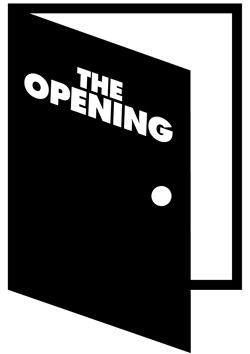 |
THE OPENING is all about delving into the fascinating, quirky and wonderful visual arts in Vancouver. Each week we’ll feature an artist, cover an exhibition, discuss a lecture and everything else in-between to delve deep into who and what makes art happen! |
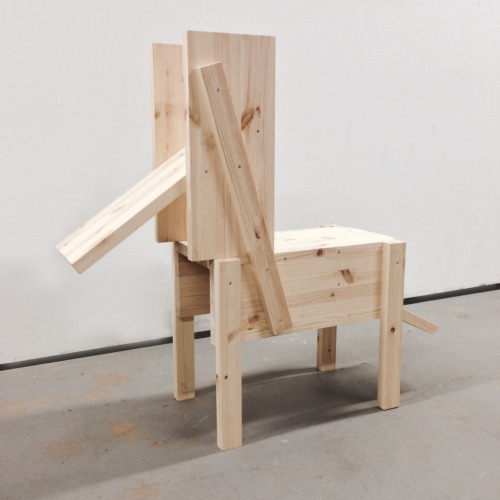 Babak Golkar, DO THE DOWNWARD DOG!, 2013
Babak Golkar, DO THE DOWNWARD DOG!, 2013
I met Babak Golkar on the first truly frigid day of November, down in the warehouse district near the train tracks. Though it was relatively early, the sky had already darkened to a deep pitch — Golkar had to hail me from his building's doorway before I was able to find my way over. His studio is well-lit and spare, populated with hanging tools and hand-built plywood chairs that, even in their bareness, have an ergonomic curve to them. Throughout our conversation, a psychedelic playlist issues from an iPad that he reaches for now and then to scroll through images of work that I was yet to encounter. He speaks eloquently and seriously, every so often cracking a wry smile should he be discussing something especially incendiary.
The occasion of our meeting is the advent of Presentation House Gallery's annual gala and auction, which will be held at hyper-hip Secret Location in Gastown this evening. To mark the event, Presentation House procured twenty-three of Enzo Mari's iconic Sedia 1 chairs — an elegantly modest precursor to the prefabricated, assemble-it-yourself furniture that populates condominiums across the world today — and asked artists and designers to build and modify the kit as they pleased with one stipulation: that they use every single piece in the package. The results are as thrilling and varied as one would expect: Beau Dick hides a cheeky raven in the chair's bottom slats, while Douglas Coupland tessellates the pieces into a television test pattern. Golkar's contribution, DO THE DOWNWARD DOG!, is a playful sculpture and seating object that is designed to do the yoga pose in mind.
In this way, Golkar's work is always both lively and profound. Its success hinges on its ability to become an experiential catalyst, encouraging interactions on bodily, retinal, and cerebral levels. In a time when most art is mediated through a screen or observed from a noncommittal distance, it's essential to feel risky and engaged in the way that Golkar's sculptures and installations move us to be.
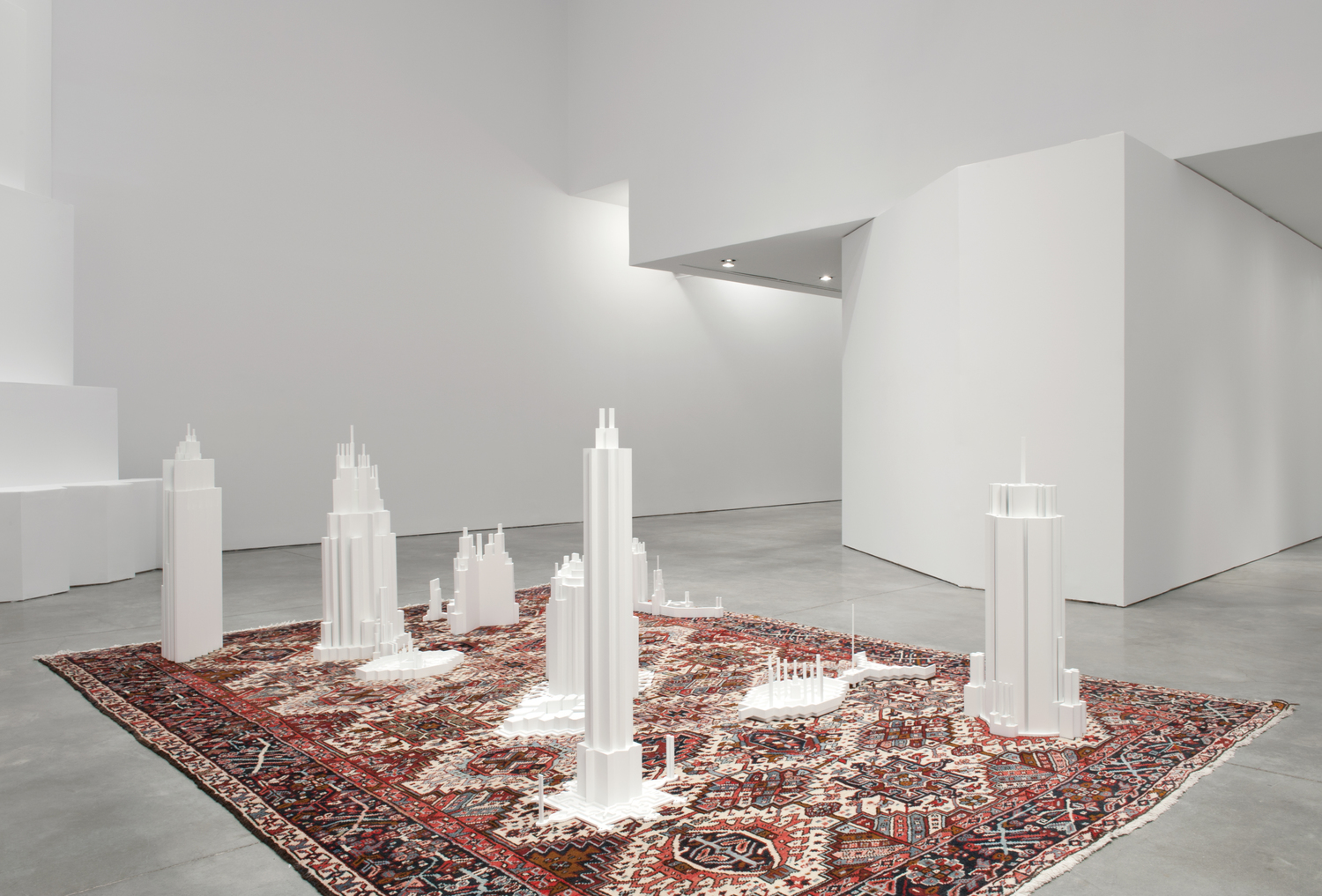 Babak Golkar, Grounds for Standing and Understanding, 2012
Babak Golkar, Grounds for Standing and Understanding, 2012
VIA: What's a typical day like for you? What are your motivations?
BG: That's a really big question. The first part of it is fine, because I have a routine. I am usually in the studio at 10 o'clock in the morning. If I don't have any meetings after hours, I leave around 4:30 or 5. It's work, or rater it’s a practice so it requires persistence. I do treat art as work — the labour of it is very important for me. In fact, I am working on a series of works that deal with the idea of art and labour and value and all that sort of stuff, so I have been very interested in committing myself to this job. The difference is that we are entrepreneurs — we don't have employers, which makes it harder to set a schedule and commit to it. That's my day, usually.
I somehow manage to have a lot of weekly meetings for different reasons. I am really interested in those, having discussions with different people from different backgrounds. Those continued conversations often trigger me to come up with ideas. I observe and connect things that don’t necessarily fit together and that becomes the ignition for a new work. I think the most challenging way of coming up with an idea is for me to be asked to do something. I find a great amount of pressure in it. Translating those anxieties and pressures into play is something that I am very interested in. It’s important for me that play is involved in the process. But, it's work in of itself, translating those anxieties into play, which is the reason why I do this — I like play.
VIA: Play wouldn't be the first thing that a viewer would tap into when seeing your work — it's quite meticulous. It's interesting to hear that that is such a fundamental aspect of what you're doing.
BG: I don't know, for me it does. The building-like structures on the carpet (Negotiating Space…), for example, come literally out of a childhood play that I used to do on the carpet. I just visualized it with 3D objects. I have to disagree, I think, but I'm not the best viewer to my own work. You are, or someone else is. Have you seen my work?
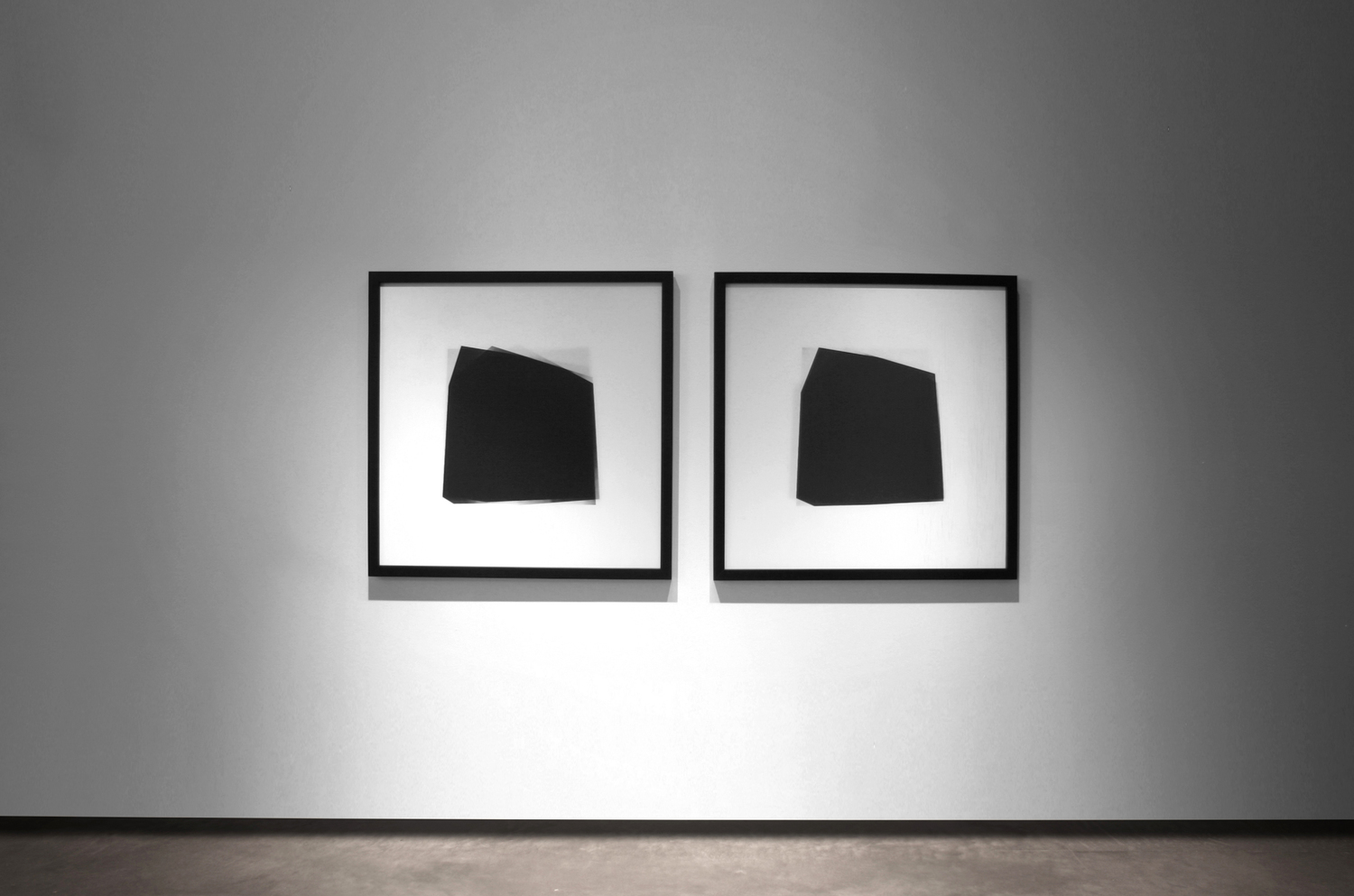 Babak Golkar, From God to Malevich, 180 View, Left to Right, Then Reversed, To Be Viewed at an Arm’s-Length, 2009
Babak Golkar, From God to Malevich, 180 View, Left to Right, Then Reversed, To Be Viewed at an Arm’s-Length, 2009
VIA: In person? Only your editions at WAAP.
BG: Yes, the lenticular work is also a good example. It plays with the eyes. It tricks me quite a bit. When I walk and try to ignore it, it's impossible. It kind of does this dance in the corner of my eyes and I have to look and double-check. I use these kinds of playful visual tricks to my advantage. I think they offer a great deal of opportunity for initial engagement.
VIA: I was wondering about 'Grounds for Standing and Understanding', and the role that these objects play for you. You seem to be attracted to objects within which there are latent narratives or ideologies. Do you find that all objects contain these narratives, or do find yourself attracted to certain ones where these narratives are more present?
BG: I don't think I can differentiate those two things. I use them as layers. There is obviously a layer of ideology in the works that is under scrutiny for me. Sometimes it comes off as not being scrutinized enough, and I'm fine with that. I also play off the language of ideology for sure. Design fits into that quite often. Architecture fits into that. I'm interested in architecture in particular because of those qualities it has — that it could have an affect on movement, on society, whatever that it meets and how it defines itself and excludes and includes. At the same time I think objects are autonomous, too. That is until they meet our gaze. As you said, there is a certain immediate quality with the works that I try to keep in order to engage. If your engagement is on that level, then that's fine, then if you want to dig deeper into certain ideologies, then there’s an opportunity for it in most of my works. If you want more, there's something more — you can dig deeper into other narratives that are conceptually tangible and contemporary, that aren't necessarily referring back into other histories.
I don't necessarily look at the history of modernism, for instance, with the same eye that some other artists do, as in with an overly critical look as if it’s a prescribed task. I look at it, I appreciate parts of it, I reject parts of it, I take the language and try to connect it to what we're dealing with now in terms of contemporary society.
VIA: The way that 'Grounds for Standing and Understanding' was realized was experience-based at first, then people encountered the sculptural object at the very end of the experience. I think almost every writer who had taken on your show had noticed that first, as well. I was wondering about your interest in creating these experiences, and how you view that as part of your practice.
You're very concerned with objecthood on one hand, and spatial experience on the other. It's linked by architecture, but it's not purely architectural —
BG: It's linked by objects, I would say. Architecture is used in my work as a spatial framework, as one context that our bodies can relate to. At the same time, I am invested in material and objecthood as much as I am interested and invested in the audience. At the end of the day, I want to be an audience. I don't want to be excluded from the public as an artist, and I like to be treated that way when I'm looking at an artwork. It's very seldom that I like an artwork, partially because sometimes they assume the public is dumb. They have a whole bunch of assumptions about the public that excludes, a lot of times. At that point, I'm public. I know I have the knowledge, and the training, and all of that, but at the end of the day, I'm public. So I'm invested in that.
In terms of the experiences that you're talking about, I want to have something tangible because we're not allowed to touch the artworks. In replacing that, I'm interested in providing an opportunity to experience something tangible or mimicking tangibility so the body doesn't have to rub against the walls of the gallery to have a tangible experience, but it can be maneuvered through a structure, and that to me is tangibility. This comes across as craft, I believe. I'm very much concerned with craft and ideas of craft, and how it is linked with tangibility. In art, for most part, we have eliminated that so it becomes visual or conceptual through text or reading.
Those are some of the links that I am very much invested in, not just interested in. Another example is my exhibition, Dialectic of Failure, at the West Vancouver Museum. I've pushed the works all the way to literal tangibility — I've made around 30 terracotta screampots that aren't glazed, but are fired, that you can pick up from a table and you can scream into them, and they'll silence you. You'll have this phenomenological experience of the work, of the space, of your surroundings, as a release. You let it go and you're OK, you're fine: nobody heard you, you can do it, scream.
I was very much interested in including the public in the completion of the work. And if they didn't want to touch the objects, that's OK — they can have a look at some ceramics and they might have a lot of questions that they might find an answer for in the exhibition or might not. The reaction and the engagement of the public has truly surprised me. Let’s say there have been a lot of silenced screams in that museum!
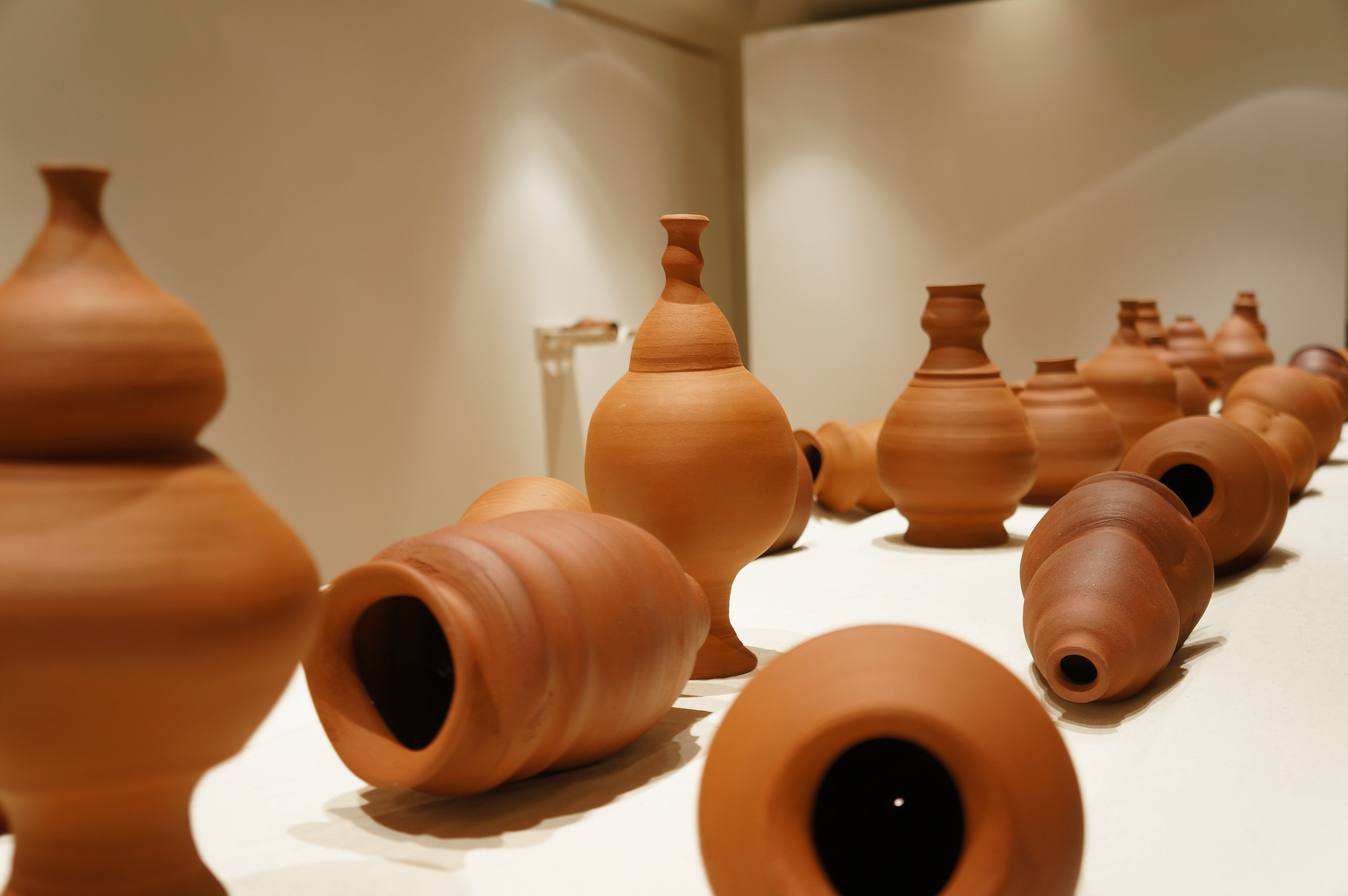
VIA: I was reading 'Thinking Architecture' by Peter Zumthor, which touched on exactly what you were talking about — how he designs spaces to engage all senses, and how problematic it is that so much architecture is designed purely for retinal experience or even just to be photographed well.
BG: On the idea of photography as documentation, I think I should say something, because a lot of the time photography is at the service of artists and it’s highly regarded as a medium of transference, but we don’t hear enough about its deficiencies. The medium allows for something to looks so good in a photo, and I don’t mean it necessarily aesthetically, and it gives the idea right away. In that regard, photography completely fails my work, because you cannot go through the experience through that medium. Text is the best way of documenting my work, but it really needs to be experienced first hand. After many of my shows, the work doesn't exist for me the same way, unless someone has these objects and they can arrange them in a similar fashion. The art is made — the idea that I have in mind — is completed by an interaction like that. Photography is just a really crippled medium for what I'm interested in communicating.
Another thing about tactility, and the experience of this, goes back to the value of art and this stigma we have — these invisible bylaws that we have in the arts that, if it's touched, it doesn't necessarily have the value of something that you're not allowed to touch. That kind of mentality, I think, drives the rules that we have. It comes down to exclusivity. You can only touch a piece by, I don't know, Brancusi, if you own it. Everyone else is excluded from touching it.
Even though we have criticized the idea of the genius artist, we are still treating the object that the artist has come up with as a relic that comes out of the same romanticized space. The artists aren't geniuses anymore, but the objects are fetishized in the way that a relic would be.
VIA: I was reading that short article after the sale of the Francis Bacon triptych, about how absurd it is that someone would even pay a dollar for an artwork, let alone $143 million. The act of paying for an artwork still links into the fetishization of these objects over any other thing.
BG: My brother sent me that article. I saw the triptych, and — this is not very well known, but — an almost identical piece to the triptych is in Tehran. There are around a hundred and fifty pieces of modern art in the Museum of Contemporary Art in Tehran, and this triptych is one of them. It's probably more valuable than the one that was sold. And with all the news between Iran and the States at the moment, I couldn’t help but comparing value systems. Thinking that the people who are running the institution in Tehran never gave a shit about those works. They just locked it in a humid basement, basically.
It's a reclining nude. Never going to come out of the vaults. They have the whole series of Mao by Warhol, plus some very exclusive ones, like Mick Jagger and a commission of the former princess and the king of Iran. And apparently, the most ‘valuable’ Jackson Pollock is also owned by MOCAT. But it's about value — it has so much value here, and it doesn't have nearly as much value there. I think they gave a very significant De Kooning in exchange for a miniature-painting page of the Book of Kings that had some calligraphy in it. They changed it with one piece of paper. That’s just as absurd as it is the other way around; it’s all about context.
VIA: On that note, I wanted to ask about a theme that comes up quite often when people write about you – people stress the fact that you live between a few places. Colloquially, we're called "third-culture kids". I saw documentation of the installation that you had in London called 'Mechanisms of Disorientation: Towards a Fragmented Understanding', and was wondering how you perceive the relationship between yourself and this identity as a fragmented or 'third-culture' individual.
BG: I think those kinds of frames work well linguistically for the market that we're talking about, value creation. That's probably a big factor as why they exist. I say it, because I'm interested in this other notion of culture that's related more to nomads — I belong to a contemporary nomadic culture, as many of us do, and I operate out of that space. I'm interested in fragments of all of these cultures, and I have so many problems with all of them. But I think we've got to go beyond those boundaries, and we will at some point.
I'm not Iranian, because I don't practice being Iranian. I'm not Canadian, because I don't practice being Canadian. And I'm not American, because I've removed myself from that. But when it's handy, I am.
VIA: That's the best answer I've ever heard for that question. Like you said, I think a lot of people in our generation inhabit this outside space, but instead of seeing it as outside existing dominant cultures, people see themselves instead as hybrids of them.
BG: I think hybridity is conformity. I think that the notion is kind of loose, but it's still conformity — you would conform to being a hybrid. And I'm not interested in that, really.
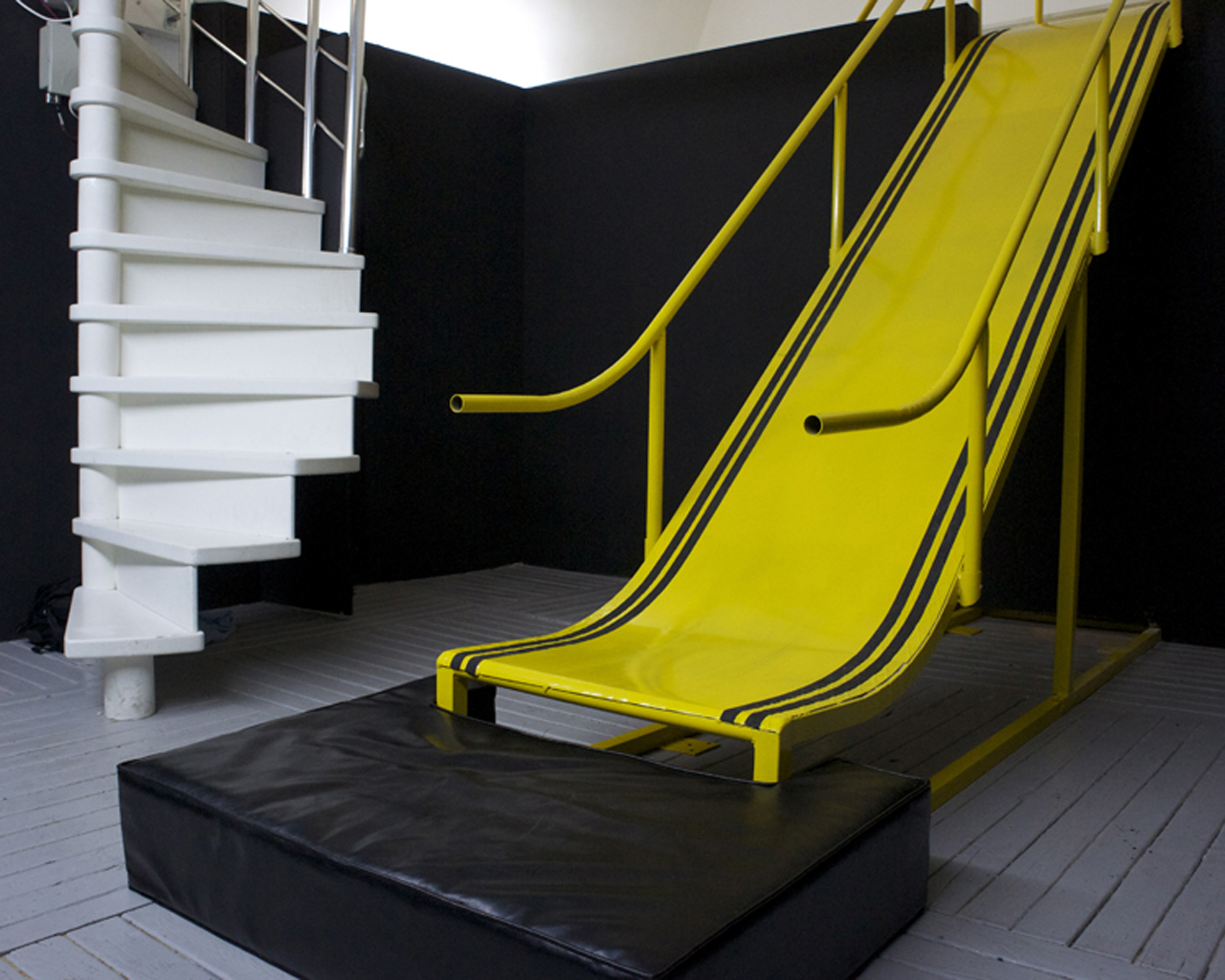 Babak Golkar, Black Cube: Moving Towards The Abstract Light, 2011
Babak Golkar, Black Cube: Moving Towards The Abstract Light, 2011
VIA: When I was clicking through documentation of your Black Cube installation — and like you said, I expect that the photography doesn't do it justice — I had this experience of being confronted by these warning signs before entering into a series of claustrophobic corridors until I emerged up top to see this fun yellow slide, but also this ominous neon. I was wondering whether fear has ever played a role in what you're doing: is it an emotion that you seek to elicit?
BG: Heavily. Heavily. I was brought up in fear, not by family, but by the war situation in Iran. It's been instrumental. And the fact that I'm an artist, as I mature more and more, even in the past year or two years, I'm trying to deal with my fears and anxieties. I mentioned anxiety right off the bat and I see a relationship to play as a form of coping. I'm really trying to get over my anxieties, but I don’t see fear as a personal issue. I see fear as our issue, our 21st century issue. It's this number one, singlehandedly most important issue that we're dealing with. If late last century, the issue was depression, fear is ours in this century. We get played really easily by fear. We get manipulated; we submit; we conform.
I have a lot of anxieties from war and authoritarianism from childhood and they carry right through. When I went to Istanbul for the first time, I fell in love with the city but immediately felt unsettled by the bullshit rules that were brewing. You could smell it in the air. When I was invited to mount a solo project a couple of year after my first visit, I made ‘Black Cube, Moving Towards the Abstract Light.’ This is the piece you are referring to. When you took the yellow slide and came inside the cube, you were confronted by the neon that spelled: ‘YOURDAYSOFFREEDOMARENUMBERED’. Sure enough a year later Istanbul went through a major clash between the government forces and public who didn’t conform. I have fear for our society. I fear for me and I fear for us — that we've been pushed into a corner and are now disengaged. That we are, in a sense, impotent and ostracized. We are so entangled with our daily activities that we are distant from everything else.
One other thing that I wanted to say about photography, and my problem with images in general, is the idea of presenting a picture that’s mediated and how information is disseminated so much through mediation that for us, our conceptual understanding relies so much upon visuality, text and hearing. Other senses are removed from that kind of experience. This becomes a major problem when it comes to understanding a circumstance from a distance — let's say, looking at the Middle East as opposed to being there. One essential factor is smell; another is tactility, taste too. We don't have that when we are in another country looking to understand from a distance. The air changes, so you smell something different and it triggers a memory. When you come back and you have, all of a sudden, a similar smell so that you create associations and your understanding suddenly becomes more comprehensive. You would relate!
I think each place, too, has its own taste. You don't have to eat it, but the fact that you breathe it — you taste it. Photography or video or audio or text is not capable of capturing the tactility of other places. In that particular sense, I'm very much interested in nomadism and experiencing an understanding in that sense.
Some of the fears that I have come out of those kinds of understandings. I feel it beyond images. It's quite impactful when you experience something like that through your tastebuds and the smell in the air. That can be taken metaphorically, or literally.
VIA: I noticed that, though we always begin with talking about the specifics of your work, our conversation ends up spinning out into more sweeping cultural and political issues.
BG: I mean, what's the point of talking about art anyways. The majority of people don't give a shit! However, my biggest interest in it is the potential to connect, to engage. It's not because I'm interested in somebody else paying attention to my work; it comes out of a place that I, as a 36 year-old person in this year, am very much interested in being engaged with my life and everyone around me. Over and over, I'm hammered with situations that push me away from that — that make me disinterested in every aspect of my daily life. I want to be interested, I'm curious, I want to be engaged, and if I can't get it, I'll make it.
_
Get in touch with Babak Golkar.
Learn more about the Presentation House Gallery auction and gala.
Follow us on Twitter (@VIAtheOpening).


